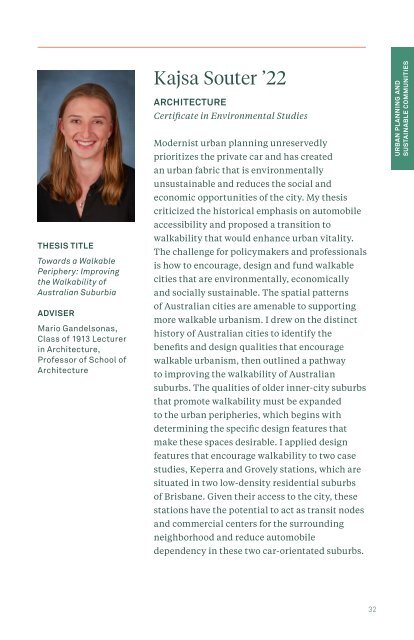Undergraduate Research: An Archive - 2022 Program
You also want an ePaper? Increase the reach of your titles
YUMPU automatically turns print PDFs into web optimized ePapers that Google loves.
THESIS TITLE<br />
Towards a Walkable<br />
Periphery: Improving<br />
the Walkability of<br />
Australian Suburbia<br />
ADVISER<br />
Mario Gandelsonas,<br />
Class of 1913 Lecturer<br />
in Architecture,<br />
Professor of School of<br />
Architecture<br />
Kajsa Souter ’22<br />
ARCHITECTURE<br />
Certificate in Environmental Studies<br />
Modernist urban planning unreservedly<br />
prioritizes the private car and has created<br />
an urban fabric that is environmentally<br />
unsustainable and reduces the social and<br />
economic opportunities of the city. My thesis<br />
criticized the historical emphasis on automobile<br />
accessibility and proposed a transition to<br />
walkability that would enhance urban vitality.<br />
The challenge for policymakers and professionals<br />
is how to encourage, design and fund walkable<br />
cities that are environmentally, economically<br />
and socially sustainable. The spatial patterns<br />
of Australian cities are amenable to supporting<br />
more walkable urbanism. I drew on the distinct<br />
history of Australian cities to identify the<br />
benefits and design qualities that encourage<br />
walkable urbanism, then outlined a pathway<br />
to improving the walkability of Australian<br />
suburbs. The qualities of older inner-city suburbs<br />
that promote walkability must be expanded<br />
to the urban peripheries, which begins with<br />
determining the specific design features that<br />
make these spaces desirable. I applied design<br />
features that encourage walkability to two case<br />
studies, Keperra and Grovely stations, which are<br />
situated in two low-density residential suburbs<br />
of Brisbane. Given their access to the city, these<br />
stations have the potential to act as transit nodes<br />
and commercial centers for the surrounding<br />
neighborhood and reduce automobile<br />
dependency in these two car-orientated suburbs.<br />
URBAN PLANNING AND<br />
SUSTAINABLE COMMUNITIES<br />
32
















